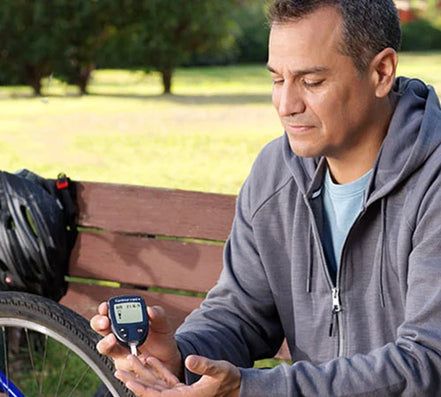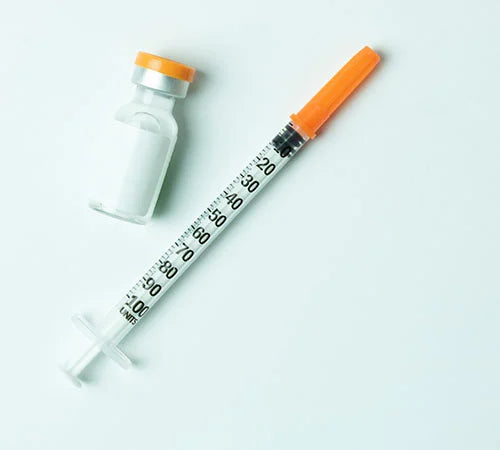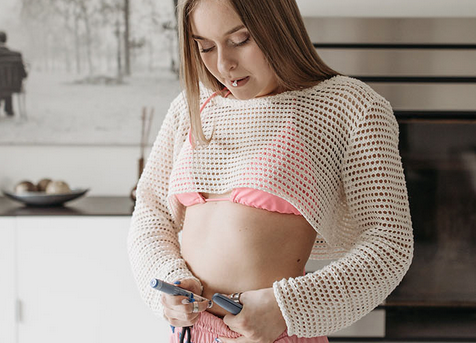What is Type 1 Diabetes or T1D?1
Diabetes is a condition where the amount of sugar (glucose) in your blood is higher than normal. Type 1 diabetes (T1D) is where the body produces little or no insulin. Insulin is needed to help sugar enter the cells of your body. The sugar comes from the food you eat and it is used in all cells and organs to generate the energy that keeps your body going.
The insulin that is missing in your body has to be replaced. Insulin cannot be taken through the mouth, but it must be injected.
Is Your Blood Sugar Level In The Healthy Range?
Food intake, delivering sugar to the cells and turning it into energy are essential processes in our bodies. The levels of sugar in the blood result from these processes. If the levels are too high or too low, there is the risk of serious consequences for your body. Therefore, normal blood sugar levels are important for your health.

Monitoring your Blood Sugar Levels with a Blood Glucose meter
Your blood sugar level can be measured using a “blood glucose meter” or “blood glucose monitor”. You simply take a drop of blood by fingerprick and the meter tells you how much sugar is in your blood at that time. This way, you can check if your blood sugar level is in the healthy range.
Monitoring blood sugar levels is the most important way you can check how well you are managing your diabetes!
T1 Diabetes Management Guidelines
To manage diabetes successfully, the blood sugar levels should be kept within the normal range by timely injections of the right dose of insulin. However, if you change your eating habits or physical activities, your blood sugar levels may become too low or too high.
Understanding the risks of blood sugar imbalance and the effects of different foods on blood glucose can help your healthcare team adjust your insulin dosage and diet effectively to maintain stable levels.
Hyperglycemia – High Blood Sugar Levels2
When the sugar level in your blood rises above the normal range, you become hyperglycemia. If your sugar level stays too high for a long time, there is a risk of damage to organs and other complications.
High blood sugar levels develop when your body does not produce enough insulin or does not respond well to insulin. It can also happen when a person with diabetes forgets an insulin injection or if the injected insulin dose was too low.
Hypoglycemia - Low Blood Sugar Levels2
Your blood sugar level can also fall below the normal range, resulting in hypoglycemia. Hypoglycemia is often called an “insulin reaction”, because it can occur after taking too much insulin. Low blood sugar levels are common with type 1 diabetes patients – on average, episodes with symptoms occur twice a week. The number of unnoticed lows (without symptoms, at night) could be even higher.
If blood sugar levels fall too low, you can lose important functions, such as the ability to think and act normally. Low blood sugar levels require immediate action!
Contact your Healthcare Professional to discuss your individual blood sugar target range.
What is the difference between hypoglycemia and hyperglycemia?
Hypoglycemia and hyperglycemia refer to low and high blood sugar levels, respectively. Understanding the distinction between these conditions is crucial for effective diabetes management. Hypoglycemia can cause symptoms like dizziness and confusion, while hyperglycemia may lead to increased thirst and fatigue. Recognizing these differences helps in taking appropriate actions to maintain healthy blood sugar levels.

T1D & Insulin education for patients3
Insulin is a hormone that is naturally produced by the pancreas. Without insulin, the sugar cannot enter the cells and piles up in the blood. Insulin is the medication for people whose pancreas does not produce enough insulin (type 1 diabetes).

Insulin Management with Blood sugar monitoring – It’s in your Hands!3
When blood sugar levels rise after a meal, insulin is needed for type 1 diabetic people to bring the sugar levels back to normal. In healthy people, the pancreas provides the right amount of insulin. People with type 1 diabetes have to inject insulin several times daily with insulin pens, syringes, or insulin pumps. Blood sugar monitoring helps you to determine when and how much insulin you need to inject. Understanding the active insulin time is crucial for determining when and how much insulin you need to inject.
Types of Insulin for Type 1 Diabetes
There are several types of insulin, based on how fast and how long they act in the human body. Your Healthcare Professional will work with you to select the one that is best for you.

Living with Diabetes – Practical Tips4
T1 Diabetes Diet and Eating Right
One of the approaches to managing diabetes is to: maintain a healthy and balanced diet. The food you eat has a large influence on the sugar levels in your blood. It is important to know your foods and to manage your insulin injections accordingly. A dietitian who has expertise in type 1 diabetes can help you set up a plan for a balanced diet, your insulin doses, and the right level of activities. When your eating habits or preferences change, it is time to update your eating plan!
Maintaining a record of your blood sugar levels and dietary intake using log books charts can be valuable for managing your condition and improving your overall health.
Type 1 Diabetes Exercise
When you move, your body consumes more energy and uses up the sugar faster than when you rest. Being active is good! In the long run, exercise will help to stabilize your blood sugar levels.
Exercise not only benefits your physical health but also helps reduce glucose spikes after meals. Always consult with your healthcare team for personalized advice.
Finding Type 1 Diabetes Support
Stress management and diabetes can be daunting. Social and emotional support can positively boost your well-being. It can be very helpful to share your experiences with other diabetics. A good network of support from family members, friends, and diabetes patient organizations really makes a difference!
Storing Insulin after opening
For example, insulin may need to be refrigerated. If the injection of cold insulin is painful for you, the insulin can be held at room temperature before injection. Some insulin products can be stored in this way for about one month. Please make sure to always check and follow the supplier’s instructions.
Are you ready to start managing your Type 1 diabetes better? Learn more about how our products can support you!
Shop Now*CONTOUR®NEXT GEN blood glucose meter shown for representation. Before use please see the CONTOUR®NEXT GEN user guide for full instructions.
- https://diabetes.org/living-with-diabetes, Accessed May 2024
- https://diabetes.org/about-diabetes/type-1, Accessed May 2024
- https://diabetes.org/health-wellness/medication/insulin-basics, Accessed May 2024
- https://diabetes.org/living-with-diabetes/type-1, Accessed May 2024


